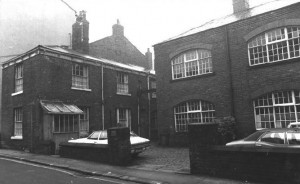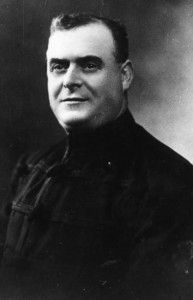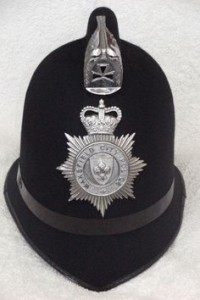Wakefield City Police – Constable 17
My father was brought up by his grandparents from being about 2 years old – the reason, well not quite sure, as both his parents were living, but have a good idea and he was the only one of his siblings being brought up by the Victorian couple.
It appears from the stories told to me by my father that his grandmother was the hub of the family. It seems she was a very strong willed woman and after the death of her husband always wore black.
What did my father tell me? I heard of three soldiers who were KIA during WW1 and their siblings and cousins who lived to be reunited with their families. I heard a tale of a hangman (but that’s another story), a very vague story about a woman who attempted to murder the Prime Minister, and the story of a policeman who used to enter the house and stand between the dresser and the back door. By the time I was born my great grandma had died – the hub of the family had gone, so I missed the vast number of relatives who used to pop by and see her.
Who was the policeman? Walter Siddle, my third cousin, was born in Wakefield in 1881 to Walter Siddle and his wife Sarah Margaret nee Walker one of their 11 children. Walter snr. worked as a hawker and salt dealer to earn a living, while home, was on Grantley Street, 90 Stanley Road and Brickmakers Yard.
Years later, I was in contact with Colin Jackson, a retired Wakefield City Policeman, who had written a fantastic book about the Wakefield Constabulary 1818 – 1968, and I came face to face with Constable 17, Walter Siddle.
Walter jnr. joined the Wakefield City Police and completed his probation on 30th September 1907 and was appointed PC17 on 16th October of the same year. The area at the time had two police forces – the City force, where you had to live within the city boundary to be eligible to join and the West Riding Constabulary which catered for those outside the city limits. Prior to him joining the police, Walter was employed as a stoker. Walter was 5′ 10″ tall, with a fresh complexion and brown hair and seems to remind me of Sgt. Dixon from Dixon of Dock Green – some of you may remember from tv series by that name years ago.
1911 is an eventful year for Walter. The census is taken and he is living with his parents and four siblings in Brickmakers Yard. This census gives a wonderful insight into family life at the time as it tells that Sarah Margaret had given birth to 13 children but by the second of April 1911, she had lost seven of her children – such a loss for all the family. But 11 days later, on Thursday the 13th of April, Walter and his family were just down the road, waiting in St Andrew’s church for Clara Leonard to walk down the aisle and become his wife. Another milestone came in Walter’s life in the autumn, when Sarah Margaret his daughter was born, followed in May of 1913 by Walter Leonard.
Life would have continued for the family but some 15 months after the birth of Walter Leonard war was declared. Men from all walks of life signed up to go, as ‘it would be all over by Christmas’. Many occupations were ‘reserved’ i.e. farmers, iron and steel workers, coal miners and doctors (although some miners and doctors did join the services) and the police. This all changed in December 1915, when all members of the police force under 41 years of age (including Walter) attested and were placed n the reserve list, under Lord Darley’s Scheme (World War 1). By March 1917, the goal posts were moved and all under 41 years of age were to be examined by the Army Medical Board, again Walter qualified for the examination.
The war ended the following year with Walter not having to go to war but 11 constables did go and fight. By reading the local newspapers for the time, it seems that the police forces had enough to deal with at home – soldiers deserting, overstaying leave and generally causing chaos was enough to keep any force (about 60 constables, 9 sergeants and 4 high ranking officers (191 nominal roll)) busy. So busy in fact, that with having to contend with the possibility of air-raids (several alarms of Zeppelins raids were reported to which the Police and Fire Brigade were put on standby), in the early part of 1916 the Chief Constable found it necessary to reduce monthly leave to only day with payment being for the extra days worked. Towards the end of 1917 daylight raids were a possibility and the Watch Committee was asked to purchase bicycles. Factory buzzers and the Town Hall bell were to be used to warn of such raids and Clayton Hospital had made arrangements for the evacuation and handling of its patients and the possible casualties resulting in these raids. Although these precautions were made, there is no record of any actual raids.

King Street Police on left with lock-up and Fire Station
In January of 1918 the Force applied to the Watch Committee for an increase in pay, it was not until December and the war was over that the men got their increase in pay and a War Bonus of 12/ ½d per week was eventually paid to regular members of the Force.
Life continued for Walter and Clara and his career seemed to be on the up. On the first day of 1920 he is appointed Detective Constable. By July 1923 he is promoted to Uniform Sergeant ‘C’, with responsibilities which include drilling the Fire Brigade and a few days later his responsibilities include the cleanliness of both the Police and Fire Stations.

Walter Siddle via Colin Jackson
April of 1931 the family move from the police house at 22 Thompsons Yard, to the Police Station at 26 King Street. In March of 1933, on the retirement of Supt. Tattersfield, Walter is promoted to Superintendent of the Fire Brigade. During his service Walter would have been serving under Inspector George Kealey Spindler, the father of Nellie Spindler, who was KIA during the war – this is another connection I have with Nellie!
On June 8th 1934 the Watch Committee were informed of the death of Superintendent Siddle. His widow, Clara, was granted a gratuity of £758 6s 8d and informed that she must vacate the property by the end of October, but in the meantime pay 23s 6d per week rent.
Clara lived to see both her children married – Sarah Margaret married Willie Rushworth Brownhill in the Cathedral in 1934. While Walter Leonard married Joan Donnelly in 1949.
Walter and Clara now rest within the boundaries of Wakefield City Cemetery, Sugar Lane.
